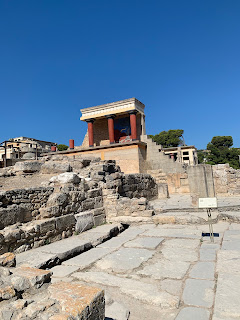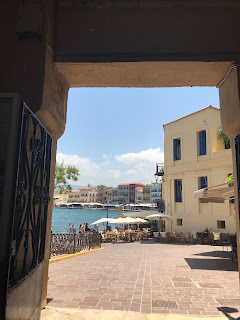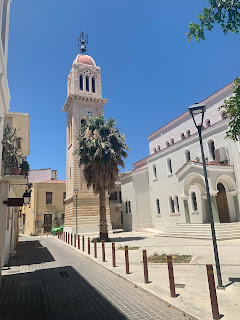Guest: Kate Forsyth - Discovering Crete
I have spent the last few years researching and writing a novel set in Crete during the Second World War, which meant I was lucky enough to be able to justify the long journey from the very big island of Australia to this much smaller island in the heart of the Mediterranean Sea.
We fly into Chania from Athens, and pick up a hire car at the airport. It only takes us 20
minutes to drive to the city, and twice as long to find a car park near the old Venetian harbour.
It’s worth the hassle. We buy gelato and walk along the stone harbour front. On one side is
the dome of an old Turkish mosque and the arched shipyards where the Venetians once
repaired their galleys, on the other side a square battlemented fortress and a pretty little
lighthouse. Behind is a maze of crooked, cobbled streets, leading into an old walled town.
Many of the houses are painted the same colours as our gelatos. We eat at a waterfront café
and then, while my family relaxes with another gelato, I go to the Maritime Museum which is
housed in the atmospheric Firka Fortress which has a World War II exhibition I want to see.
Crete is the birthplace of Zeus and the cradle of European civilization. Humans have lived on its shores for about 130,000 years, with waves of invaders over the years including the Romans, the Byzantine Empire, the Venetian Republic, and the Ottomans.
The Nazi invasion of May 1941 and the ensuing four years of German occupation are raw in
the Cretan memory. Farmers still plough up shells, and houses still bear the marks of
machine-gun bullets. Waiters ask us where we are from. When we say ‘Australia’ their eyes
light up. They all have a story of an Australian soldier shielding a child or hiding in a cellar.
They all have stories of Nazi atrocities. They don’t know that I am writing a novel about the
Crete during the war. When I tell them, they are exuberantly pleased. ‘Sometimes it feels as if
our war has been forgotten by the rest of the world’, they tell me. Even though Crete was the
first place that the Germans faced stout civilian opposition and the first time they suffered
significant German losses. Nearly four thousand Nazis died in the first three days. By the end
of the bitter and bloody 11-day battle, they had lost 7,000 men, over a third of their force.
From Chania we travel to Rethymnon, a beautiful little town of ancient churches and
mosques and narrow cobbled alleyways filled with shops and restaurants and tall, narrow
houses with doorknockers shaped like a woman’s hand. From here we will explore as much
of the island as we can.
Crete is dissected neatly in two by a series of towering mountains that remain snowy even in
summer. The northern half of the island faces Europe, and features wide sandy beaches, olive
groves, and the winding trellises of small vineyards. Fruit trees blossom profusely on the high
fertile plateaus, and every village has a stone church with a quaint belltower and old men
playing backgammon under the pollarded mulberry trees of the taverna.
The southern half of the island faces North Africa, and so is blasted by the hot red winds
from the desert. The mountains plunge straight down into the water, and every road is
narrow, winding and steep. Villages are tiny and far spaced, and the landscape so bare and
stony it is lunar. It is not a place to blow a tyre.
As we slowly navigate the hairpin-turns of the mountain road, which hugs the edge of a
plunging precipice, I experience vertigo for the first time in my life. Tiny roadside shrines at
every switchback only enhance the sense of danger. I wind down the window, and breathe
deeply of the crisp air, scented with the wild thyme that clings in every crack. When we stop
at a lookout, the only sound is the wind and the distant ting of a goat’s bell. Overhead I see a
griffon vulture soaring through the vast blue sky, its wings wider than a man is tall. This is a
wild, remote, ancient landscape, a place where it is easy to imagine gods and heroes once
lived.
We spend most of the day exploring the south coast, site of many a daring landing by Allied
undercover spies during the long occupation. We hike down steep rocky tracks to discover
tiny, deserted beaches where the water is so clear, you can see the shadows of birds flickering
across the sand fathoms below. We find a little taverna with views to the sea, and eat lamb
roasted with lemon and drizzled with tzatziki and – as always – a decanter of tsikoudia, the
clear, heady pomace brandy tourists call raki, even though it is nothing like the aniseed-
tasting Turkish drink.
The next day we go to the Palace of Knossos, near Heraklion. This is the key setting for my
novel The Crimson Thread, which is a 20 th century reimagining of the famous Minotaur in the Labyrinth myth which originated here. It is the earliest known Western palace complex, built 4,000 years ago, with high-rise buildings decorated with lively frescoes, a theatre for an
audience numbering in the hundreds, and flushing toilets. It was destroyed around 1450 BCE
by an earthquake thought to have caused by a volcanic eruption of the island of Santorini,
which lies to the north. For thousands of years it lay buried and forgotten, till it was
rediscovered in the early 1900s by the British archaeologist Sir Arthur Evans. He built a
house on a hill overlooking the palace ruins and named it the Villa Ariadne, after the mistress
of the labyrinth who gave Theseus a spool of red thread so that he could find his way free of
the labyrinth after killing the minotaur. After the Nazi invasion of May 1941, the villa
became the headquarters of the German divisional commander. When Sir Arthur heard the
news, he suffered a heart attack and died a few weeks later.
Sir Arthur controversially rebuilt many of the palace buildings, using modern materials such
as steel and concrete, a move which horrifies modern archaeologists but does help tourists
like me imagine what the ancient city may have looked like. The lower chambers, with its
vivid frescoes, stone bath and alabaster throne, are particularly evocative.
In Crete, the mythological past is ever-present. It is seen in the mountain behind Knossos
where Zeus is said to be sleeping, and in the labyrinthine ruins of the ancient palace with its
broken frescoes of bull-leapers and dancers, and in the fascinating figurines of goddesses
with snakes writhing up their arms. My novel The Crimson Thread takes this mythological
past and weaves it through a story of courage, heroism, and love set during the desperate days
of the German invasion and occupation of 1941-1945.
Dr Kate Forsyth is the bestselling and award-winning author of The Crimson Thread, a
reimagining of ‘The Minotaur in the Labyrinth’ myth set in Crete during the Nazi invasion
and occupation of World War II. Other novels include Beauty in Thorns, a reimagining of
‘Sleeping Beauty’ told in the voices of four women of the Pre-Raphaelite circle of artists and
poets; The Wild Girl, the story of the forbidden romance behind the Grimm brothers’ fairy
tales which was named Most Memorable Love Story of 2013; and Bitter Greens, a retelling
of ‘Rapunzel’ which won the 2015 American Library Association award for Best Historical
Fiction.
You can find out more about Kate's work at www.kateforsyth.com.au and The Crimson Thread is available from Amazon, Blackwell's and all good bookstores.









